

The Chemistry of Dienes and Polyenes. Volume 1
Edited by Zvi Rappoport
Copyright ∂ 1997 John Wiley & Sons, Ltd.
ISBN: 0-471-96512-X
CHAPTER 7
The photochemistry of dienes and polyenes: Application to the synthesis of complex molecules
JOHN M. NUSS |
|
Chiron Corporation, 4560 Horton Street, Emeryville, CA 94608, USA |
|
e-mail: John Nuss@cc.chiron.com |
|
and |
|
FREDERICK G. WEST |
|
Department of Chemistry, University of Utah, Salt Lake City, UT 84112, USA |
|
e-mail: West@chemistry.chem.utah.edu |
|
I. INTRODUCTION . . . . . . . . . . . . . . . . . . . . . . . . . . . . . . . . . . . . . . |
264 |
II. PHOTOREARRANGEMENTS OF DIENES AND POLYENES . . . . . . . . |
264 |
A. Bond Migration . . . . . . . . . . . . . . . . . . . . . . . . . . . . . . . . . . . . . |
264 |
B. Electrocyclic Ring Opening of Cyclic Dienes . . . . . . . . . . . . . . . . . . |
265 |
C. Electrocyclic Closure of Dienes and Trienes . . . . . . . . . . . . . . . . . . . |
268 |
D. Sigmatropic Rearrangements . . . . . . . . . . . . . . . . . . . . . . . . . . . . . |
276 |
E. Di- -methane Rearrangements . . . . . . . . . . . . . . . . . . . . . . . . . . . . |
277 |
F. Rearrangements of Cross-conjugated Dienones . . . . . . . . . . . . . . . . . |
280 |
III. PHOTOCYCLOADDITIONS INVOLVING DIENES |
|
AND POLYENES . . . . . . . . . . . . . . . . . . . . . . . . . . . . . . . . . . . . . . |
296 |
A. [2 C 2]-Photodimerization of 1,3-Dienes . . . . . . . . . . . . . . . . . . . . . |
296 |
B. Paterno Buchi¨ Reactions Employing Conjugated Dienes . . . . . . . . . . |
297 |
C. [4 C 4]-Photocycloadditions . . . . . . . . . . . . . . . . . . . . . . . . . . . . . |
306 |
D. Other Higher-order Photocycloadditions . . . . . . . . . . . . . . . . . . . . . |
313 |
IV. CONCLUDING REMARKS . . . . . . . . . . . . . . . . . . . . . . . . . . . . . . . |
319 |
V. REFERENCES . . . . . . . . . . . . . . . . . . . . . . . . . . . . . . . . . . . . . . . . |
319 |
263
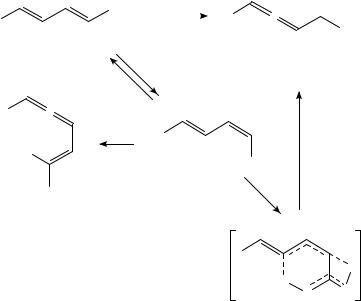
264 |
John M. Nuss and Frederick G. West |
I. INTRODUCTION
Organic photochemistry has typically been approached from a physical/mechanistic perspective, rather than a synthetic one. This may result from a certain reluctance on the part of synthetic chemists to employ reactions which often produce many products. Nonetheless, careful design of substrates can lead to high levels of chemoselectivity. In fact, there have been many recent examples of the successful application of photochemical reactions to the synthesis of complex targets1. In many cases, these processes provide access to unique modes of reactivity, or offer unrivaled increases in molecular complexity2.
The literature of diene and polyene photochemistry provides many cases of synthetically useful reactions. As a result, certain arbitrary decisions have been made regarding what is covered in this chapter. For example, intramolecular [2 C 2]-photocycloaddition reactions of ˛,ω-dienes can be formally included under the general rubric of diene photochemistry. However, we have chosen to restrict our discussion to dienes and polyenes which constitute a self-contained chromophore, viz. conjugated, cross-conjugated and 1,4- diene systems. Likewise, arene-olefin photocycloadditions will not be considered. These two broad classes of photoreactions have been applied extensively in synthesis, and have been the subject of recent reviews3,4.
II.PHOTOREARRANGEMENTS OF DIENES AND POLYENES A. Bond Migration
Photoenolization is a frequently encountered process for aromatic and ˛,ˇ-unsaturated carbonyl compounds5. Typically, an allylic or benzylic -hydrogen is abstracted by the
|
CO2 H hν, Et2 |
O |
• |
||
R |
|
|
|
R |
|
|
|
|
|||
|
1% HCO2 H |
CO2 H |
|||
|
|
||||
|
|
|
|
|
|
|
hν |
|
|
(1a) R= H, 32% |
|
|
|
|
(1b) R= CH3 , 20% |
||
|
|
|
|
|
|
R •
R
X
HO
CO2 H
OH
(3)
R
H
H
O O
(2)
SCHEME 1
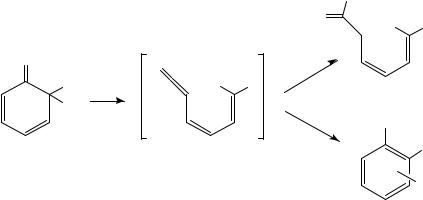
7. Application to the synthesis of complex molecules |
265 |
oxygen of the photochemically excited carbonyl. In contrast to their saturated counterparts, which produce a 1,4-diradical capable of either fragmentation or closure to cyclobutanol, these systems lead to dienols, also referred to as photoenols. These intermediates can then undergo ketonization to give the isomeric ˇ, -unsaturated carbonyls, or take part as diene partners in Diels-Alder cycloadditions. In the case of ˛,ˇ, ,υ-unsaturated carbonyls, the vinylic -hydrogen is presumably somewhat less reactive. However, Crowley reported that irradiation of sorbic acid or 2,4-pentadienoic acid in the presence of formic acid furnishes 1, presumably involving prior photochemical cis/trans isomerization of the C-2/C-3 alkene (Scheme 1)6. This leads to a net deconjugation of the unsaturated carbonyl, with concomitant creation of an allene. This process does not occur with the corresponding carboxylate salts, and only in low yields with methyl sorbate. To explain these differences, a transition state (2) involving simultaneous transfer of the - and carboxyl hydrogens was invoked, rather than photoenolization to give 3, followed by tautomerization.
B. Electrocyclic Ring Opening of Cyclic Dienes
The photochemistry of linearly conjugated 2,4-cyclohexadiene-1-ones (e.g. 4) has been studied extensively7. These linearly conjugated systems generally photorearrange to a (Z)-dienylketene 5 (equation 1); this process is usually reversible, so that in the absence of a nucleophile little change is observed. In the presence of amines or alcohols, however, amides and esters are typically isolated. In the presence of weaker nucleophiles a slow formation of phenol derived products is usually observed.
|
|
|
|
XR1 |
|
|
|
|
|
|
O |
R |
|
|
|
|
|
R |
||
O |
O |
|
|
|
|
|
|
|
|
HXR1 |
|
||
R |
• |
R |
R |
|
||
X = O, NR |
(1) |
|||||
hν |
||||||
R |
|
|
|
|
||
|
|
|
|
|
||
|
|
|
|
OH |
|
|
(4) |
|
(5) |
|
|
R |
|
|
|
|
|
R
An early example of this process is typified by the formation of photosantonic acid 7, isolated in high yield when 6 is irradiated in aqueous solution (Scheme 2)8. Barton and Quinkert have also utilized this ring opening/trapping process in the synthesis of dimethylcrocetin, 10, as well as other derivatives of this diapocarotenoid9. Double C-alkylation of the 2,6-dimethylphenol with 1,4-dibromobut-2-ene affords the requisite (bis)cyclohexadieneone 8 in modest yield. Irradiation of 8 in methanol affords a mixture of isomeric dimethyltetrahydrocrocetins (9), which on dehydrogenation with DDQ leads to a mixture of compounds from which the naturally occurring dimethylcrocetin 10 can be isolated.
Quinkert and coworkers have also described a clever synthesis of the lichen macrolide (C)-aspicilin (17) using this ring opening/trapping strategy in which the trapping is done intramolecularly by a remote hydroxyl functionality, affording a macrolide product
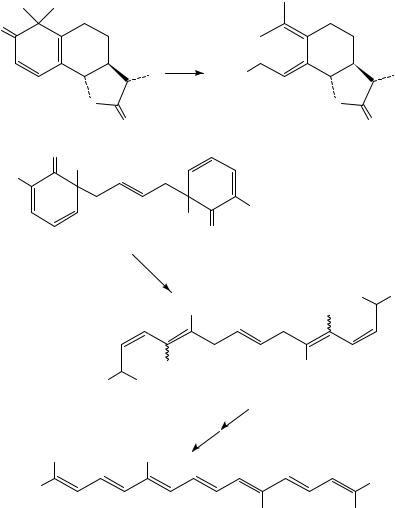
266 |
John M. Nuss and Frederick G. West |
|
|
O |
|
|
|
|
|
hν |
|
|
|
HO2 C |
|
|
|
H2 O |
|
O |
|
|
O |
(6) |
O |
(7) |
O |
O
CH3
H3 C
CH3
H3 C
(8)O
|
CH3 OH |
hν |
|
|
|
|
|
|
|
|
|
|
H3 C |
CO2 CH3 |
|
|
CH3 |
H |
|
|
|
H |
H3 C |
|
H3 CO2 C |
CH3 |
|
(9) |
|
|
|
|
|
CH3 |
CH3 |
CO2 CH3
H3 CO2 C
CH3 |
CH3 |
(10) |
|
SCHEME 2 |
|
(Scheme 3)10. Indeed, independent photolysis of 2,4-cyclohexadien-1-ones 12 and 13 afforded the macrolides 15. These reactions likely proceed via a common intermediate, in this case dienylketene 14, which is trapped intramolecularly by the pendant hydroxyl group. Adjustment of the oxidation level and functional group interconversion then led efficiently to the desired macrolide 17. The sulfonyl group was used for two reasons: first, to easily transform lactones 15 into dienyl lactones 16 needed for 17, and secondly, to control the regiochemistry of the Wessely oxidation of phenolic precursor needed to produce the photolysis substrates 12 and 13.
Schultz and Kulkarni have explored the possibilities of using this process in asymmetric synthesis by trapping the ketene generated from these photochemical ring-opening
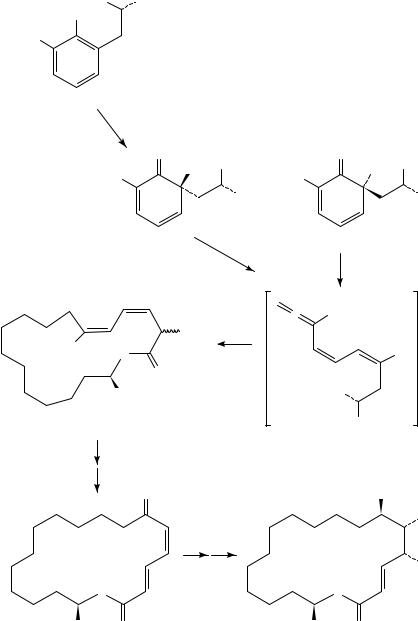
7. Application to the synthesis of complex molecules |
|
|
|
267 |
||||
H3 C |
OH |
|
|
|
|
|
|
|
OH |
• |
|
|
|
|
|
|
|
PhO2 S |
( )10 |
|
|
|
|
|
|
|
(11) |
|
|
|
|
|
|
|
|
|
O |
CH3 |
|
O |
|
|
|
CH3 |
|
OAc |
|
|
|
OAc |
|||
PhO2 S |
• |
PhO2 S |
|
|
|
|
• |
|
|
|
+ |
|
|
|
|
||
|
( )10 |
OH |
|
|
( |
)10 |
OH |
|
|
(12) |
hν |
|
(13) |
|
|
|
|
|
|
|
|
|
|
|
|
|
|
|
|
|
hν |
|
|
|
|
|
|
|
O |
|
|
|
|
|
|
|
|
• |
SO2 Ph |
|
|
|
|
AcO |
SO2 Ph |
|
|
|
|
|
|
|
O |
|
|
|
|
|
OAc |
||
|
|
|
|
|
|
|||
|
O |
|
|
|
|
|
|
|
|
CH3 |
|
|
HO |
• |
( |
)10 |
|
|
|
|
|
|
|
|||
|
|
|
|
|
|
|
|
|
(15) |
|
|
|
|
CH3 |
|
|
|
|
|
|
(14) |
|
|
|
|
|
|
O |
|
|
|
|
|
OH |
|
|
|
|
|
|
|
|
|
OH |
|
|
|
|
|
|
|
|
OH |
O |
|
|
|
O |
|
|
|
|
CH3 |
O |
|
CH3 |
|
O |
|
|
|
(16) |
|
|
|
(17) |
|
|
|
|
|
SCHEME 3 |
|
|
|
|
|
|
|
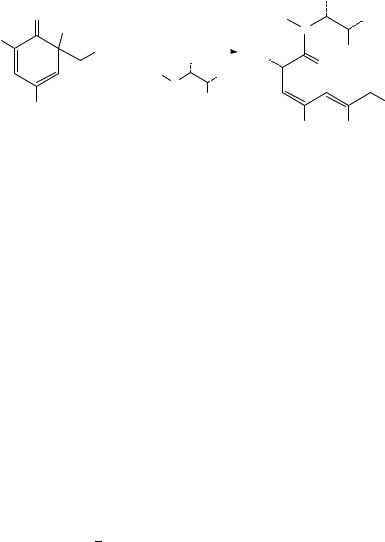
268 |
John M. Nuss and Frederick G. West |
reactions with a chiral, nonracemic amine or alcohol (Scheme 4)11. Preliminary studies indicated that irradiation of 18 in the presence of a chiral, nonracemic amine (or amino alcohol) led to only moderate yields of the amide or ester products. The best chiral modifier in this case is the (D)-ephedrine, 19, which gave a ca 70:30 ratio of diastereomers. The authors did show, however, that this method is preparatively useful, as multigram quantities of optically pure 20 can be produced easily.
|
|
|
|
|
|
CH3 |
|
O |
|
|
|
H3 C |
• |
Ph |
|
CH3 |
|
|
|
N |
|
• |
|
H3 C |
|
hν |
|
|
|
OH |
|
CO2 CH3 |
|
|
|
|
|
||
|
|
|
|
H3 C |
|
||
|
|
CH3 |
|
O |
|||
|
|
|
|
|
|||
|
H3 C |
|
• • |
|
• |
|
|
|
N |
Ph |
|
|
|||
|
|
H |
OH |
|
|
||
CH3 |
|
|
CO2 CH3 |
||||
|
(19) |
|
|
|
|||
|
|
|
|
|
|||
|
|
|
|
|
CH3 |
|
CH3 |
(18) |
|
|
|
|
|
(20) |
|
SCHEME 4
C. Electrocyclic Closure of Dienes and Trienes
Electrocyclic closure of butadiene units encased within cycloheptane rings has been used to obtain bicyclo[3.2.0]heptene systems (Scheme 5)12. For example, irradiation of eucarvone 21 led to the formation of adduct 22 in 52% yield via a disrotatory ring closure12a. This adduct was used as a key intermediate in the synthesis of the pheromone grandisol, 23, which proceeded in 20% overall yield from 22. In their synthesis of ˛-lumicolchicine, Chapman and coworkers utilized a photochemically initiated fourelectron disrotatory photocyclization of colchicine to produce ˇ-lumicolchicine 24a and its -isomer 24b in a 2:1 ratio12b. These adducts were then converted, in a second photochemical step, to the anti head-to-head dimer ˛-lumicolchicine 25.
In conjunction with studies probing [4 C 4]-photocycloaddition chemistry of 2-pyrones (vide infra), West and coworkers recently reported observations regarding alternative rearrangement pathways13. Irradiation of 6-hydroxyethylpyran-2-ones 26 furnished novel dihydropyrans 27 (Scheme 6). Although the details of the mechanism are not available, initial closure to bicyclic ‘Dewar pyrone’ 29 is considered to be a likely pathway14. When the length of the tether connecting the pendant alcohol to the 2-pyrone was increased, spirocyclic products 28 were formed instead.
The hexatriene/cyclohexadiene isomerization has been extensively studied and has been the topic of numerous reviews and monographs15; this section will attempt to deal only with applications of these reactions to synthesis, and in particular the use of these reactions for the synthesis of natural products. Much of the early work in this area was done by Havinga and coworkers during the course of their detailed work on the stereochemical consequences of the thermal and photochemical conversions in the vitamin D field16; this work provided much of the impetus for the development and elaboration of the Woodward Hoffman rules (Scheme 7)17. The reversible photochemical ring opening of provitamin 30 to precalciferol (31) and the photochemical ring closure of 31 to lumisterol 32 can be explained by consecutive photochemically allowed conrotatory processes16.
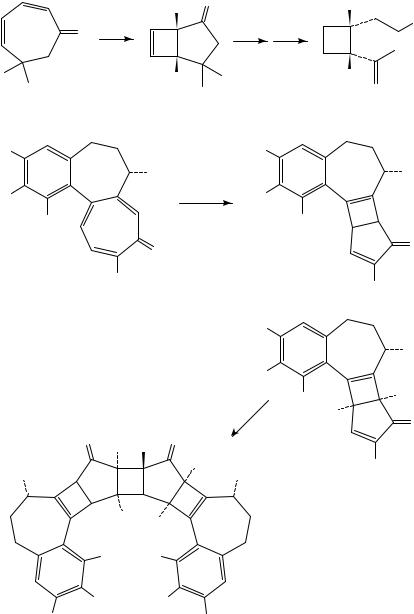
(21)
RO
RO
OR
Ac HN
RO
7. Application to the synthesis of complex molecules |
269 |
O
H3 C
O hν
H
|
(22) |
|
|
|
RO |
|
NHAc |
|
|
hν |
RO |
|
R = CH3 |
|
|
O |
|
OR |
|
|
|
|
RO |
|
|
+ |
|
|
RO |
|
|
hν |
O |
O |
|
RO |
OR |
|
|
H |
|
• |
|
NHAc |
• |
|
|
• |
|
|
|
|
|
H |
H |
|
|
|
|
OR |
RO |
|
OR RO
OR
(25)
SCHEME 5
H3 C
OH
CH3
H
(23)
NHAc
OR |
• |
• |
|
|
O
OR
(24a)
NHAc
OR |
H |
|
H
O
OR
(24b)
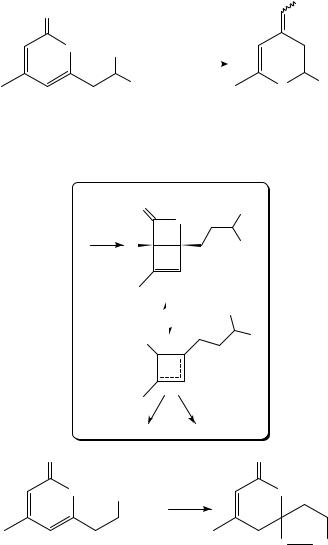
270 |
John M. Nuss and Frederick G. West |
O
O |
OH |
1. hν, MeOH |
|
||
|
|
|
|
|
|
|
|
2. cat. HCl, THF |
|
R |
35−74% |
(26a) R= (CH2 )2 -(2-furyl)
(26b) R= Ph
(26c) R= 2-furyl
(26d) R= (CH2 )2 Ph
(26e) R= (CH2 )2 −
(5-methyl-2-furyl)
Proposed Intermediates:
O
O
( )n
hν
26 H
|
29 |
||
|
|
|
R |
−O2 C |
|
|
( )n |
|
|
||
|
+ |
||
CO2 H
O R
(27a) R= (CH2 )2 -(2-furyl)
(27b) R= Ph
(27c) R= 2-furyl
(27d) R= (CH2 )2 Ph
(27e) R= (CH2 )2 −
(5-methyl-2-furyl)
R
OH
OH
|
27 |
28 |
O |
|
O |
O |
(CH2 )nOH |
O |
|
hν |
|
|
|
|
|
|
CHCl3 |
|
O |
(CH2 )n |
(26f) n = 1 |
(28f) 65% |
|
(26g) n = 2 |
(28g) 75% |
|
SCHEME 6
In an interesting illustration of these reactions, the two disymmetric trienes (C)-33a and ( )-33b were found to preserve their chirality upon photolysis at 193 K and provide cyclohexadienes 34a and 34b, respectively (Scheme 8)18. Upon warming above 205 K, however, they lose their chiral integrity by competitive disrotatory cyclization to the achiral dienes 35a and 35b. The thermal disrotatory closure to the cis-fused ring isomer is generally found to be extremely facile in these systems.
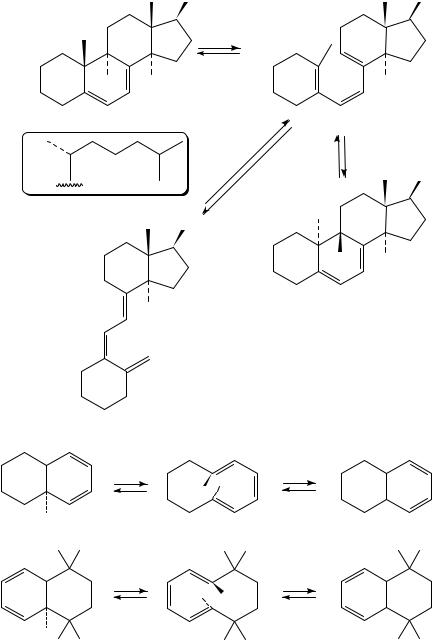
7. Application to the synthesis of complex molecules |
271 |
R |
R |
HO
(30)
R =
HO
•
H
(34a)
•
H
hν
H H
HO
∆
R
HO
H
SCHEME 7
hν |
|
H |
|
H |
|
|
|
|
|
(+)-(33a) |
|
hν |
H |
|
|
H |
|
|
|
|
(34b) |
(−)-(33b) |
SCHEME 8
H
(31)
hν
R
H H
(32)
∆ |
• |
|
|
|
• |
|
(35a) |
∆ |
• |
|
|
|
• |
|
(35b) |
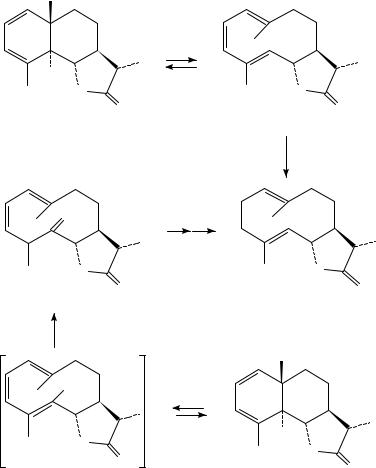
272 |
John M. Nuss and Frederick G. West |
In one of the earliest applications of this type of process to complex molecule synthesis, Corey and Hortmann, in their synthesis of dihydrocostunolide 38, found that photolysis of 36 afforded a photostationary state of 36 and 37 (Scheme 9)19. Hydrogenation of this mixture then gave 38. A recent modification of this synthesis, which avoids the photostationary equilibrium between eudesmane (36) and germacrane (37) forms, was realized using a modified substrate, 3920. Irradiation of 39 provided a 77% yield of a mixture of diastereomeric ketones 41; these are produced via tautomerization of the intially produced trienol 40. Dienone 41 was then easily converted to 38 via a series of conventional steps (Scheme 9).
hν |
|
H |
|
O |
O |
O |
O |
(36) |
(37) |
Lindlar |
H2 |
catalyst |
O
O |
O |
|
O |
(38) |
O |
(41) |
|
OH
hν
OH
O
O
O
O
(40)
(39)
SCHEME 9
A similar strategy has been employed in a clever synthesis of the sesquiterpene dihydronovanin (44)21. Enol acetate 42 was irradiated in cold methanol to prevent thermal closure to the cis-fused system via a facile disrotatory electrocyclization (Scheme 10).
